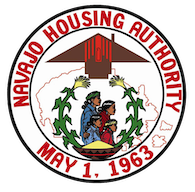HUD, SWONAP PRESENT TO NHA DURING APR FORMULATION PROCESS - 09-12-24
GALLUP, N.M.—The Annual Performance Review formulation process took place Sept. 9-13, 2024, at the Hilton Garden Inn in Gallup.
Division chiefs convened with management to discuss the APR development and ensure that projects were ready for submission to the U.S. Department of Housing and Urban Development.
A presentation from the HUD Southwest Office of Native American Programs Administrator Dr. Corinne Stiles was during the Sept. 10 morning session.
Stiles and her team met with NHA and provided an overview of the SWONAP functions as it relates to oversight of tribal housing.
SWONAP deputy administrator Floyd Tortalita reported first and reassured everyone that HUD was there to help and provide guidance and technical assistance for the annual submission of the Indian Housing Plan and the APR.
“We are here to assist NHA in your needs and to move the program forward,” he said.
Tortalita said he has been with Indian housing 24 years, 16 of which he served as the executive director of the Pueblo of Acoma Housing Authority.
IHPs and APRs are important because they are reporting activities, the amount of funds available in the Line of Credit Control System, and programming preparation for the coming year.
“We know it’s no secret that Navajo Housing Authority is under a microscope and that there’s a lot of people watching,” he said. “We need to make sure that those reports are as accurate as can be and we’re here to assist.”
Tortalita said the SWONAP staff would review timelines, gates, what is important for the APR, and what HUD requires before submission.
“We are here to help, that is what we are here for. Navajo being successful means we are successful,” he said.
Stiles spoke next and said she and her team from SWONAP that traveled with her were new to the program.
“When we stepped into our positions, we recognized fairly quickly that there were some things we needed to resolve and address internally before we could be a good partner externally,” she said.
She said the Feb. 2024 “landscape review” uncovered issues with how team members were treating each other.
“If that’s the way it looks, it’s likely that’s the way we’re treating our grantees too,” she said. “And that’s not going to work for me.”
The growing pains are over, however, and Stiles said the program has evolved into one that is “a really good partner and collaborator and one that people are excited to work with.”
Stiles offered up an alternative meaning for the SWONAP acronym and said it could also be an abbreviation for Seeking Wisdom, Overcoming obstacles, and Nurturing Ancient Paths.
The new acronym is also symbolic of the new mindset that SWONAP has with working with its grantees.
SWONAP is a part of the HUD Office of Native American Programs, she said, which covers the entire country with six offices.
“We’re the one in the Southwest,” she said. “Our mission is to increase the supply of safe, decent, and affordable housing available to Native American families and to strengthen communities by improving living conditions and creating economic opportunities to tribes and Indian housing residents.”
Compared to other tribes in the HUD portfolio, NHA is the largest tribe in terms of funding allocation from HUD and land base.
“We want to make sure that we’re doing things correctly and providing the support that you need,” she said.
Stiles reviewed the programs managed by SWONAP, including the Indian Housing Block Grant, Indian Community Development Block Grant, Section 184 Indian Home Loan Guarantee Program, and Title VI Loan Guarantee Program.
New miscellaneous programs she mentioned included the Coronavirus Aid, Relief, and Economic Security Act and American Rescue Plan Act.
Stiles said the Consolidated Appropriations Act of 2024 or HR4366 represents $467.5 billion in government spending.
The six spending bills covered by the Act include agriculture, commerce-justice-science, energy-water, interior-environment, military construction-VA, and transportation-HUD.
“There was $1.34 billion was for Native American programs,” she said.
“We will give you whatever it is you need to be successful. We also offer technical assistance, and this is typically one-on-one assistance to a particular track or if you choose to apply for something,” she said. We are so happy to do this work, and we are happy in our work because it leads to more success and that leads to increased housing in Indian communities.”
###

